The story of our Bearhawk started back in 2008, as an adventure with a family that hadn’t even been fully populated with its humans yet. It ended in August 2021, with, shall we say, liquidation. What follows is a long story that perhaps nobody else will read, but sometimes one finds that there is a story stuck inside that just needs to get out.
Here’s the short version: Fire! Bad! Insurance, that helps. Still, bad/sad. There were good times. Still sad, but that’s important.
Fire! Bad!
I was out on the road for a work trip, as I am around half of the time. In fact, I was sitting in the hotel in PHL, editing a video when I got a call from the airport owner. He’s also a part of the local fire department, and was on his way back from a vacation at the beach. He got a call from some of his friends at the fire department telling him they were responding to a call at his place, and to see if he was burning brush or something. We later learned that the neighbors had called in the fire, after hearing the sound of it and probably seeing the smoke. There were a few minutes before we knew exactly what was burning, but before long he was able to forward a photo taken by the first responders:
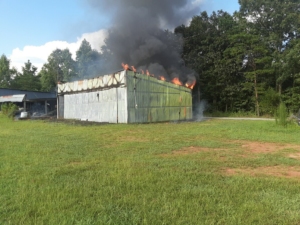
As you can see in the picture, there wasn’t much for them to do as far as saving our hangar. Thankfully they did successfully keep the fire contained and ours was the only loss. Later that evening, it was pretty clear that there wasn’t any need to rush home to protect anything from further damage. There was only one work day left in my trip, so I’d be home soon enough to deal with it.
I let a few especially close people know, including Tabitha, who said, “That’s really sad!” At the time I was still in response-planning mode but in the months since, I reflect on her first words as an especially apt summary.
Once I got back into town, we went out to see what there was to see. The steel parts were mostly still there. There was very little aluminum left, other than that which had puddled and then solidified on the ground. The ground probably provided good heat sinking to keep the aluminum from being combusted. The hangar had one large steel truss in the roof structure, and that ended up on the fuselage.


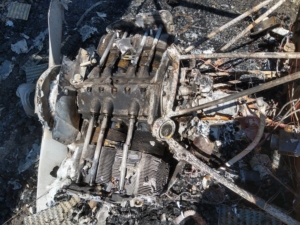
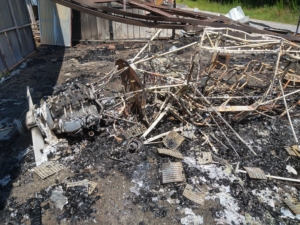
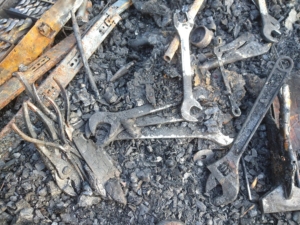
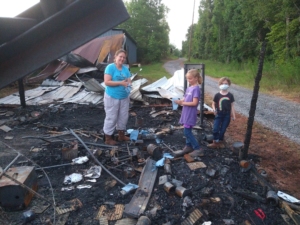
I was thinking several thoughts. On the one hand, everything was “gone,” at least in the sense of being useful anymore. But oddly, everything was still there too, in the sense of being a mess to clean up. Every nail and screw that held the building together was still there, just scattered across the ground. The steel portions of the tools were in a pile where the toolbox used to be, or where I had left them. Last year’s spark plugs were in the pile where the trash bag used to be. There was still water in the melted and deformed rain barrel behind the building that I used for hand washing.
Since the wings are mostly aluminum, and aluminum melts at a mere 1200 degrees F, they were mostly gone. The steel structure that spaced the main spars was still there, as were the aileron and flap cables, and the steel portions of those parts. I had around 30 gallons of fuel on board, and it was clear that there was some very intense heat in the boot cowl and forward cabin area, perhaps as this fuel became liberated. Wires protruded through the instrument panel where switches and avionics used to be. I found some pieces of just about each avionics part, except for the ipad that I kept as an EFB. My nice camera was not far from its last known position in the back seat, where I had left it for some upcoming aerial photos. The tools and survival kit were also piled up there, and must have made their way through the cabin floor and onto the ground fairly early. There was at least one swatch of their cotton tool bag that had been sufficiently insulated to not burn.
The firewall also yielded some interesting lessons. Before the fire, I would look at an airworthy firewall and everything looked pretty good. After the fire, it was especially clear to see what had been aluminum, and what large holes those parts left after they melted. This has changed my mindset in our replacement airplane as I decide how to fill holes in the firewall, though to be fair, hopefully an in-flight fire would be a much shorter event with lower temperatures.
I hadn’t wanted to take our daughters to the site, knowing that there were so many sharp edges to be cautious of, but I needed to take Tabitha so they had to come along too. I’m glad they did. The hangar meant something to all of us, and the girls earned the right to see the end result, with many hours of self-entertainment and occasional collaboration. We all dug in the ashes together, talking about what we found, especially in the pile where the toolbox used to be. Airplanes are ephemeral, but there’s something permanent about tools that can build more airplanes that may come and go. At least usually there is, but most of these tools would soon be in the scrap pile.
Insurance, that helps
Monday morning meant reaching out to our airplane insurance agent and our homeowners and auto insurance agent. Our fuel trailer had been in the hangar, thankfully empty, and it was covered on the auto policy. We weren’t sure if the homeowner’s policy was going to cover the non-airplane hangar contents yet, but were hopeful. We knew the structure itself didn’t have any coverage, but it was also fairly humble in its cost to build, if not its cost to replace. Of our claims, the airplane was the largest and thus the most important to prioritize. We were promptly in touch with the adjuster, and he wasn’t sure he was even going to need to come see it. In the end he decided that he would, so I met him at the hangar a few days after the fire. He said, “this is an easy one” and didn’t stay long. I’m glad he came, because he prompted me to look for the dataplate that had been on the tail. It hadn’t occurred to me to look for it, and he didn’t want to keep it, but I did. He did take a photo for his files. I verified that he wasn’t going to want any of what was left, and that we had his clearance to begin the cleanup. The site was quite a hazard and it was a priority to expedite getting it stabilized. At that time, the front wall was still mostly standing. It couldn’t have been more than two weeks before we had a check in the mail for the declared hull value, which was certainly a crucial blessing. Though as you might expect, if I had been selling the plane, I would have asked for a little more than that hull value.
Our home/auto adjuster also came out pretty soon after the fire. We learned that they would be able to provide coverage for the contents, so I began making the list of everything that we knew of that had been in there. It’s funny, if you had asked me the day before the fire to make a list of everything in the hangar, I would have been confident that I could do that. I’ve spent literally thousands of hours in there, and know not only what all is in there, but where it is. But once I started making the list, my confidence waned. One thing that made it harder was that we had just recently moved into our new house, which does not yet have its own hangar or adequate workspace. So there were several items that I had taken to the now-burned hangar as interim storage. Some of these I had forgotten about entirely until I found clues in the remains, such as our automatic chicken door opener and my scrap lead collection. Even now, 7 months later, I occasionally think of something else that was in there. If you are reading this, next time you go to your hangar or workshop or any other space, take a few pictures. Open each drawer of your toolbox and snap a photo. You never know when it might be useful.
As I made the list, I knew I probably needed to exclude some things. There was half a sheet of Makralon, for example, and lots of scraps of 2024T3 that were big enough to be useful, not to mention a new Dynon heated pitot tube and a mostly full bottle of car wash soap. You get the idea- all of those small things like a can of LPS or a tube of fuel lube that aren’t expensive one-by-one, but when you go to buy them all, it adds up. For my own private list, I added everything and anything I could think of, hoping that a brain dump would aid in catching as many “claimable” things as possible. Thankfully in these days of e-commerce, I had original purchase receipts for many things. And of course we were able to find evidence anything ferrous in the ashes also. In the end I decided that I’d only populate the insurance company list with things that I either had a receipt for, had a picture of from before the fire, or had a the remains of. In the end, they did not dispute anything on the list, to their credit.
The claims process for the homeowners was off to a rocky start, especially compared to the airplane claim. Our adjuster was a nice enough guy, but around three weeks after the loss, a different person reached out from the “investigations” department. He was much less helpful, and gave us all sorts of busy work to do. In some cases this was duplication of other paperwork we had already done, along with some very unnecessary notarizing and other such hassles. If I put on my tinfoil hat, I have to think that these are just barriers to try and wear us out, at a time when more hassle is the last thing we need. Whether or not that was the intent, it certainly was an effect, along with some very real frustration and motivation to escalate rather than cooperate. He expressed concerns about how we had already begun to clean up the site, and I explained that we were limiting exposure to further claims by reducing the risk that the site created. If he had been interested in seeing the site within even a few days after the loss, he would have been welcome, but popping up out of the blue weeks later was not going to be an option. Also, our prior contacts with the company had not included any instructions to preserve the site, not that I would have been willing to do so for three weeks, even if they asked. We owe the land owner better treatment than that!
After a month or so of dealing with “agent foul” we eventually graduated from his process and moved back over to the friendly land of claims. The trailer claim was straightforward, but I wasn’t sure of exactly how the contents was going to go. We had an extra endorsement that provided replacement cost for contents. By the way, if you have this option, you should absolutely take it! In my list of 200 or so items in the claim, I provided current replacement costs and links to where the items could be purchased. I doubted they would just take the sum of that column in the spreadsheet and write me a check, and indeed they did not. The general principle is that they will provide the replacement cost if the items are actually replaced, but they only provide the depreciated actual cash value if we want the money but not the items. I can see why they would want to do this, but it does provide some rather backwards incentives. If there’s something that I don’t really need anymore, but they insist that I replace it, well I’m going to replace it. And probably sell it for less than they paid for it, but yet for more than their ACV. In the end it probably would have saved them around $20,000 if they had just paid me based on my list, so I’m glad they didn’t.
The actual course of events was something that I hadn’t at all expected. They hired a third party called Five Star Replacements. This company has at least two main functions. One is that they can take the list of items that I provided, and then return back to the insurance company a replacement cost and depreciated ACV for each item. In this sense they are sort of a referee and third party validator of the list and its monetary value. The second function is that they can actually order the items, and have them sent to me. The first function was not optional but the second was. Upon first hearing about it, I was extremely skeptical. I bought most of everything that was in there once, and knew it wasn’t all easy to get. I had some cheap Chinese tools but also had some very expensive specialty tools that I didn’t want to replace with cheap imports. The folks at Five Star had a compelling case though. The process would be that they would send me their list of proposed replacements, which I could then reject or accept on a line-by-line basis. And while I’d have plenty of hours of hotel time in which I could order all of this stuff, there was something to be said for them spending all of that time instead of me. Anything that I was going to replace on my own (or in a few cases, already had replaced) would require me spending the money up front, then providing receipts to the insurance company. For the items that they purchased, all of this would be handled on their end. Something else I had noticed was that almost everything on the list was going to cost more this time than when I first purchased it. Current supply chain and inflation frustrations would be theirs if they were ordering the replacements, instead of mine. It was starting to sound like a pretty good deal, or at least worth seeing their list.
In the end their list was very good. We made a few mutual adjustments, and in very few cases, I elected to purchase items on my own and pursue replacement. I suspect they were probably making their money as a percentage of the overall spending, or at least let’s say I didn’t pick up on any pressure from them to source cheaper replacements. Most of the misunderstandings between my first list and their first list were caused by the way I had listed things, such as listing four different diameter rolls of safety wire as a single item, instead of one line for each roll type. There were only a few items where we needed to stick to a specific brand or item and they were accommodating in all cases. As of today, there are still a handful of items that they have not replaced, though they are mostly back-ordered or otherwise unavailable. Who knew how hard it was to become in spring 2022 to get Milbar safety wire pliers? Oddly, some of the readily-available commodities like the plastic folding table and propane tank have proven hard to get sorted, but it seems they are still working on it, if slowly. In the end, the hangar contents claim has proven to be a truly important mitigation, even if incomplete, particularly as we progress with getting back into working on and flying our replacement airplane.
Still, bad/sad
Even back in the earliest days of our project, I was mentally/emotionally prepared to lose the airplane. It was always insured, beginning with the day we purchased the kit parts, and we knew that we were building a flying machine that was quite fragile in the context of the big bad world, just as all flying machines are. I haven’t had a hard time accepting its loss, though I still do mourn it. I feel more frustration than surprise or sadness. Over the life of the airplane, there were various stages of readiness or fitness. There were times when I had a list of things to address or fix, and times when I was really pleased with how I had solved a particular problem. As of the day of the fire, I had just finally found the end to a years-long oil leak, finally reached reliable cylinder cooling, and just installed a new fancy carbon monoxide detector that would display on the avionics. With the pandemic beginning to moderate and the kids reaching a good travel age, we had lots of plans to put the airplane to good use in the coming years. It was configured and equipped just exactly as we wanted, and the hangar was equipped with the perfect stash of spare parts, tools, and supplies. These are the frustrating aspects. My mindset from the first flight until the last was that the airplane was ultimately there to keep us safe, and if its total destruction was required to do so, that option was always on the table. We built it to be a long-lasting and reliable machine, which is the paradoxical nature of airplanes, and so many other things including ourselves. We prepare for them to last a century but know they might not see tomorrow.
Despite that, I was not prepared mentally/emotionally for the cumulative loss of the airplane, everything in it, plus the hangar, and everything in the hangar, all at once. If we ended up with a forced landing somewhere that damaged the plane, we’d still be able to salvage quite a bit from it, plus we’d have a place an the tools to repair or replace it. The hangar fire removed that consolation. If we were to be lucky enough to buy a flying replacement Bearhawk, where would we put it? Or perhaps a partially completed project, but where would we work on it? I knew that we were not in a stage of life that would allow for building a new kit from the beginning, even though we knew we would have excellent support from Mark at the kit factory, and that the skills and knowledge from the first plane would make for a mighty fine second one.
We knew after the fire that our first priority was to replace the hangar. An airplane might become available, but if it did, we’d still need a hangar. We spent much of the September after the fire working through a plan, deciding on what type of building we would want and how we could make it so. We devised a budget and timeline, and ordered the all-steel building and door. There would be a delay in getting these things, so we placed our deposits and waited. Soon after, a replacement airplane became available, and it was too good of an opportunity to pass up. So we paused the hangar project, and brought home the new airplane. As luck would have it, a new roof-only hangar became available a few spots down the hill, and we were able to secure that. It has a little work space in the corner, which is fantastic for storing tools and supplies, and even has a modest little work bench. Our new hangar steel arrived last week, and next week I’ll be shrink-wrapping it for indefinite storage, while we wait for the price of concrete to come down, wait to save more money, or probably some of both.
There were good times.
It’s a strange and uncommon position to reflect on the entire life of an airplane. We become accustomed to airplanes lasting a long time, moving in and out of our lives. But with this one, it was different. I was onboard for its first flight and its last, and indeed every other flight it ever made. In its 470.8 hours, we visited friends and family, new and old places, and shared many rides. Some rides were with strangers and some with some people very special to us. Some started out in the first group and became members of the second. It was the first-ever airplane ride for probably a dozen or so people, and the first-ever Bearhawk ride for just about everyone that flew. It was a training platform for several new Bearhawk pilots, and the teacher of many lessons to all of us, especially me. Our long list of goals for the plane remains incomplete, but there are some especially noteworthy accomplishments. There was the time we flew down the shuttle runway at Cape Canaveral, the workplace of my grandfather, the day after his internment nearby. It made four trips to Airventure, three times with the family on board and once with a paramotor and Mike. There was that time when we landed at 0MS0, the place where I learned to fly model airplanes and drive a tractor. We made several trips back to VA04, the Bearhawk birthplace, and one trip to FFA, the airplane birthplace (subject to debate, I know). We never did touch down at our new home airport, but we did make several low approaches and used it for aerial scouting before purchasing the land, through the construction of the house, and after.
Still sad, but that’s important.
The first night back in town after the fire, with the whole family at the site and with the sun beginning to set, just as it can happen when building an airplane, I was about to be reminded of how sometimes the task that seems hard can be easy, and sometimes the hardest part isn’t even on the to-do list.
It was starting to get dark, so we loaded a handful of mementos and the kids into the car to go pick up take-out supper from the Mexican restaurant. Then my friend Ron drove up, just as he had on a hundred other dusks before. I asked my wife to go make the supper run and then come back to get me- I needed to talk to Ron. Ron is a hunter, and he comes on the airport property to hunt. He’s the kind of hunter that has a connection to the land. He was born and raised within walking distance of the airport, and he knows it with the kind of detail and familiarity that only comes from years of observation. Like the scratches on an old wood floor, there’s no faking genuine experience. He comes at dusk because that’s the space between day and night and shift change for the animals.
After the customary expression of condolences, he told me that he understands, better than probably anybody other than us, the scope of what it took to create the airplane and the hangar, because he witnessed it one step at a time. I can tell you that it took 2000 hours over 4 years to build the plane, and you can hear that, but Ron knows it. He has experienced the scope of it, just as I did. His words took me to a place that I didn’t realize I needed to go to. I’ve had dozens of kind messages and offers to help, but Ron’s came from a different place, from a bond that I didn’t realize we had. Sometimes things sneak up on me like that. He was right, something that I suspect happens more often than not. There are only a handful of people who did truly experience the scope of the project. His connection to the meetings and partings of the environment, the breathing, rhythm, and the cycle of it all, also connected him to me in a way I would have never known until the loss. Is he connected like this because he is a good hunter, or is he a good hunter because of the connection?
We talked for a few minutes and caught up on the latest news. We bid our farewells and he turned his truck around to head back up the road. It was getting too dark to see much more, and my mind started connecting the dots to the other bonds that the airplane has enabled, and the goodwill that it has allowed us to share. It enabled so many first-ever airplane rides, a few last-ever airplane rides, and inspirations that will coast off into the future, ready to sprout and thrive in ways that I have no expectation to know about. The end of (or at least the newfound lapse) in this phase was just sinking in when Ron yelled, “Hey, if it weren’t for that big pile of melted metal right there, I’d have never met you.” And that was the first time in this process that I found real grief, which is adhered to real gratitude just as tightly as the molten aluminum was to the dirt on the hangar floor. Thanks Ron, you’ve changed my life in ways you probably have no expectation to know. This is the kind of true and simple human connection that makes airplane building, and I guess the rest of life, all worthwhile.